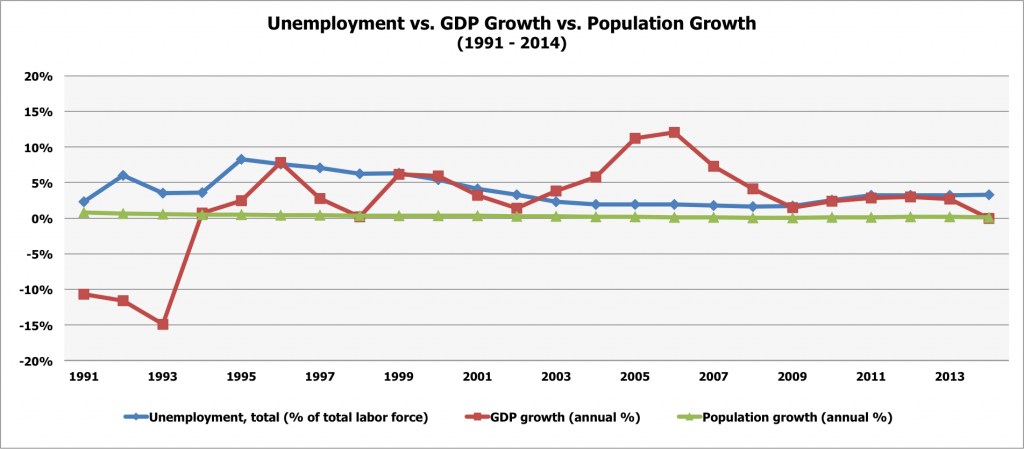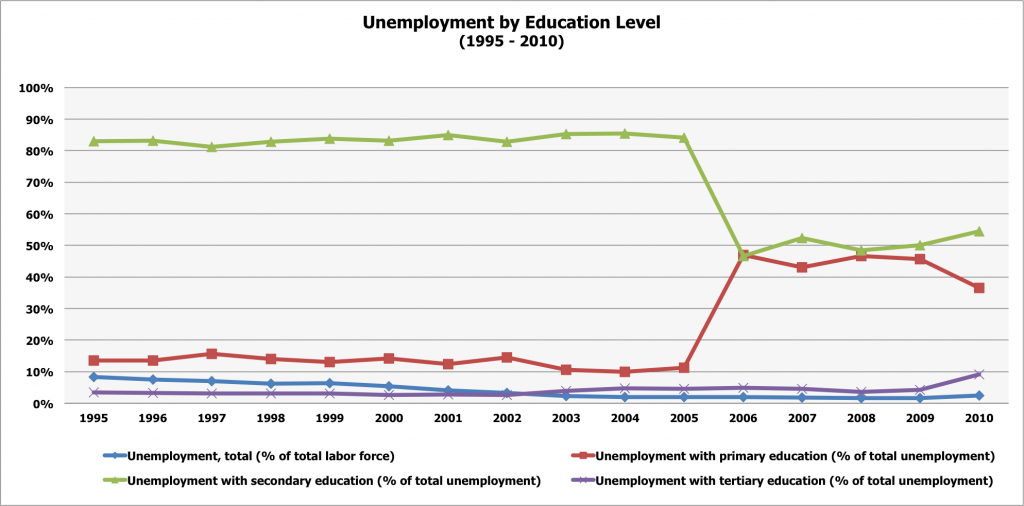Fast Facts (2015 Estimates):
– Total Population: 11,031,433 (July 2015)
– World Ranking: 80
– Unemployment Rate: 3% (2015)
– World Ranking: 24
– Strong correlation between education levels and unemployment rates.
Overview:
Unemployment provides a glimpse into the economic health of a country, as it is tied to a variety of macroeconomic factors. Available data on Cuba’s unemployment rate only goes back 25 years. However, it gives us a good idea of how the economy has been doing. Over the past 25 years, Cuba has had some wild swings in unemployment, reaching a high of 8.3% in 1995 and then continuously dropping for 10 straight years to reach a low of 1.6% in 2008. Currently, the unemployment rate is at 3.3%, which is relatively low for a country with an almost stagnant economy, very little GDP growth (just under 2%), and very little trade with the outside world (Cuba primarily trades with Venezuela and has very few trading partners).
Unemployment & GDP:
Over the past 25 years, we can see the negative correlation between unemployment and GDP in Cuba. Furthermore, we can also see the lagging effect of unemployment following GDP growth.
In the early to mid 1990s, GDP growth was negative, but started to sharply increase in 1993 and 1994, going from about -15% to almost 1% growth. However, unemployment was increasing still and hit its highest rate, maxing at 8.3% in 1995. Thereafter, unemployment started to gradually decrease for over 10 years, while GDP growth increased (with some minor fluctuations through the early 2000s). In 2006, GDP growth hit its peak at 12%, while unemployment was almost at it’s lowest of about 2%. This correlation makes sense. When the country is growing, consumers have jobs, are happier and have more money to spend. They fuel the economy, while extinguishing unemployment. Since the late 2000s, both GDP and unemployment have stabilized at around 2.5 – 3.0%. Although, there are probably a large number of people that are excluded from the labor force, which may be a contributor to the low unemployment rate, the actual unemployment rate may be a bit higher (which Cuba’s government may be hesitant to show). Nevertheless, as investors we are optimistic about investing into Cuba. Creating jobs will simulate not only GDP growth but also bring out the real unemployment rate, as unemployment can never be zero due to seasonal and frictional unemployment.
Unemployment & Population Growth:
A second important factor that correlates with unemployment is population growth. Typically, with a growing population, GDP increases as well because consumers are optimistic and have more disposable income to spend, and vice versa. However, Cuba’s population growth has been essentially 0% over the past 25 years, and thus, completely uncorrelated with unemployment or GDP growth, which have both fluctuated.

Furthermore, the net migration in Cuba is negative, meaning that people are leaving the country and not contributing to the (un)employemnt of the country. As of 2015, roughly 71% of the total population is in the employed workforce (15-64 year old), which represents employment opportunities for businesses and government run organizations, as well as a large consumer base. However, not all age groups have experienced positive growth. The 0-14 year old population has been steadily declining since the mid-1970s. Thus, there are fewer employees entering into Cuba’s workforce, which is one of the reasons for the country’s lower unemployment rate. Over the long-term, if this trend continues, Cuba will have a shortage of workers, which will negatively affect its economic growth and productivity levels.
Cuban workers are underemployed because they are currently underpaid and would work more if they were financially motivated to do so. The Cuban government does not make this possible at the moment, as it provides employment and pays fixed wages to employees. Since the government creates job, unemployment is relatively low in Cuba. Although the government creates jobs, it does not seem like there is much training available or or reduction of business regulations. In fact, prior to the 2011 economic reforms implemented by Raul Castro’s government, small business ownership and entrepreneurship businesses were not allowed to exist, as all free enterprise was prohibited. Only now has the government slowly allowed small shops to be run by entrepreneurs.
Unemployment by Gender, Education Level, and Age:
We further examined unemployment, diving into gender, education levels, and age. The only available data for the age groups was for youths. Unemployment by gender and age is closely correlated to total unemployment. At the peak, in 1995, the female population was at 10% unemployment vs. 7.5% for men, while total unemployment was at 8.3%. However, youth unemployment was significantly higher than male and female unemployment, reaching a high of almost 17% in 1995.
When we looked at unemployment by education levels, we saw that there is an interesting story going on in Cuba. First, we looked at unemployment for the portion of the individuals with a tertiary education level. Unemployment for this group of the population was relatively constant over the 15-year period for which data was available, averaging about 4%, and reaching a high of 9% in 2010. Next, we compared unemployment rates between individuals with primary and secondary education levels. From our comparison, we discovered that the unemployment rates for these two education levels are the mirror opposites of each other. Since the mid-1990s, unemployment for those with secondary education was extremely high (toggling between 80% and 85%), while unemployment for those with primary education was significantly lower (in the 10%s). In 2006, both groups converged around 47%, and have since slightly fluctuated within the range of 36-55%.
 We can infer a couple of things from this pattern of unemployment. It appears that during the mid-1990s to mid-2000s, a secondary education was not valued and/or there was simply no need for it. The majority of jobs did not require special skills or knowledge, and thus, the people with a primary education filled those jobs, hence the much lower unemployment rate. As time went on and the country expanded, there became a higher demand for people with a secondary education. This may be a result of the government requiring better-educated employees working in the various departments. Also, as the government allowed for more entrepreneurial opportunities, those with a secondary education were the best fit to start and run those businesses.
We can infer a couple of things from this pattern of unemployment. It appears that during the mid-1990s to mid-2000s, a secondary education was not valued and/or there was simply no need for it. The majority of jobs did not require special skills or knowledge, and thus, the people with a primary education filled those jobs, hence the much lower unemployment rate. As time went on and the country expanded, there became a higher demand for people with a secondary education. This may be a result of the government requiring better-educated employees working in the various departments. Also, as the government allowed for more entrepreneurial opportunities, those with a secondary education were the best fit to start and run those businesses.
We concluded our analysis by looking at the labor force participation rate, which has remained relatively steady over the past 25 years. We then factored in gender and saw that the participation rate for males has been slowly decreasing, while the participation rate for females has been slowly increasing. Furthermore, we saw that the labor force participation rate for males is higher than that of females, which coincides with the unemployment rates by gender (unemployment rates for being lower for men and higher for women).
Outlook:
As investors, we initially have to be careful about understanding the real unemployment rate due to season and frictional unemployment and the number of discouraged workers who are currently out of the labor force. The rise of entrepreneurship and the probability of increased (foreign and domestic) investments into the country are factors that would create more jobs and engage the workforce at all levels. In turn, these two factors would help to reveal and then lower the real unemployment rate (which we assume is higher than the currently stated 2.5%) and also stimulate GDP growth. Over time, we believe that these two factors will be positive for Cuba and that the real unemployment rate will decrease.
Sources:
The CIA World Factbook
The World Bank – World Development Indicators



